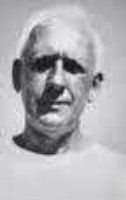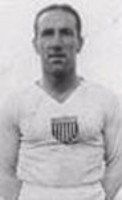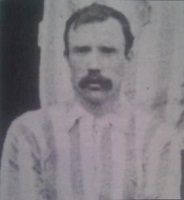

This is a story of who and how, or rather whos and how. The whos are Bart McGhee, Bartholomew McGhee, the first Scot to score a World Cup goal, and Robert Millar, Robert Joseph Millar, another Scot, and the man to have taken McGhee to that moment. The how must be left to unfold as the tale is tellt.
The moment in mind is 13th July 1930, about three twenty-three in the afternoon to be more precise, just four minutes after the netting of the first ever goal in the World Cup by the Frenchman, Lucien Laurent. The place was the Central Park Stadium in Montevideo in Uruguay. By then the two of them, Millar and McGhee, would have at least known of each other for the best part of a decade, if not more. Their paths would also have crossed on the field, as opponents and briefly as team-mates, in 1923 at the New York Field Club, with Millar then aged a veteran thirty-three and Bart twenty-four, and again in 1928 at the New York Nationals, There Millar was player/manager. Now their relationship is as player and manager.
Bob Millar might even have known Bart's father, James, for perhaps two decades and known of him for a decade more still. He would not have played against the father back in the old country, nor really seen James McGhee at either club or international level. Although McGhee Snr did play briefly at the end of his career for Abercorn in Paisley, Millar's home-town, it was when he was a baby. However, there are two buts. The first is that at Abercorn McGhee Snr. had played with Bob's elder brother, Harry. Fifteen years senior he also turned out as centre-forward for Abercorn in 1891-2 and for St. Mirren the following season before the best part of a decade down South, notably well over a hundred appearances for Bury. The elder McGhee might even have been known from the touchline. In 1908 he had been appointed manager of Hearts and, although he left the club under difficult circumstances in December 1909 by that time Millar, 5ft 11 ins, a whippet with a shock of blond hair, was already himself playing for St. Mirren. The Buddies and Hearts were both in the Scottish First Division and they had that season already played twice. The first was a home win in August 1909 for St. Mirren, 2-0. The second was also a St. Mirren win, this time away, 1-2, in the November.

It may simply have been protecting himself. It may perhaps have been a Scot, used to what he interestingly called "organised football" and reacting to an owner, whose ethos he had grown to dislike. Whatever was the reason it proved to be the right move. The ASL clubs in the end stepped back as disorganisation began to affect their bottom lines and Bob Millar found his alternative position. He was appointed manager of the US national team, no doubt in the knowledge via the AFA and FIFA that there would in 1930 be the first World Cup, the professional version of Olympic football,and that if the the USA had a team and turned up it would play. At that moment it became Bob Millar's task to make precisely that happen, with Bart McGhee, who would continue more or less as the New York Nationals until 1931 except for a brief busman's holiday back in Philly at the Field Club in 1929, as an integral and ultimately crucial part of his plan. The US team would reach the semi-final of that first World Cup before being kicked off the park by a, shall we say, ruthless Argentina. Bob Millar would retire immediately on returning to US soil, in later life living in Kings in New York with his wife, Helen, and daughter, Mary, and working as a barman. He owned the Bob Millar Cafe, now the Mussels and More restaurant at 8001 5th Avenue, Brooklyn. And he would die in 1967 aged 76 on Staten Island. Bart McGhee would retire the following year in 1931 and return to Philadelphia. In 1930 he was married with two boys, a daughter followed, and living on South Reese St. in the centre of the city a short distance from where he had grown up. Like his father, a plasterer, when playing football, he was working in the building trade as a floor-layer, whilst clearly playing the game on the side. In 1940 he was recorded still as a labourer, in the year before his father's passing. And he himself would die aged 79 in 1979 still in Philadelphia, in the northern suburb of Norristown."I hereby advise you that I must refuse to continue as playing manager of the New York Nationals Football Club. I hereby tender my resignation, because to engage further in unsanctioned soccer football will materially endanger my status in organized soccer and will thereby affect my future livelihood as a professional soccer player. You have not lived up to the terms of my contract, which call for me to play and manage under the rules and regulations of the United States Football Association, and by forcing me to engage in outlaw soccer, you are breaking my means of gaining a living. I am compelled to seek a position in organised football."
